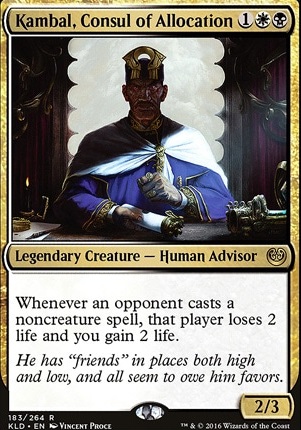| Date added | 7 years |
| Last updated | 2 months |
| Legality | This deck is Commander / EDH legal. |
| Rarity (main - side) | 20 - 0 Mythic Rares 43 - 0 Rares 15 - 0 Uncommons 8 - 0 Commons |
| Cards | 100 |
| Avg. CMC | 2.86 |
| Tokens | Copy Clone, Treasure, Vampire Knight 1/1 B |
| Folders | comander stuff, Other Peoples decks to use for ideas |
| Votes | |
| Ignored suggestions | |
| Shared with | |
| Views |
Creature (26)
- 1x Archangel of Thune
- 1x Athreos, God of Passage
- 1x Basilica Screecher
- 1x Bloodthirsty Conqueror
- 1x Cliffhaven Vampire
- 1x Crypt Ghast
- 1x Divinity of Pride
- 1x Erebos, God of the Dead
- 1x Esper Sentinel
- 1x Grand Abolisher
- 1x Heliod, Sun-Crowned
- 1x Kambal, Profiteering Mayor
- 1x Karlov of the Ghost Council
- 1x Kingpin's Pet
- 1x Liesa, Shroud of Dusk
- 1x Lotho, Corrupt Shirriff
- 1x Mangara, the Diplomat
- 1x Serra Ascendant
- 1x Sheoldred, the Apocalypse
- 1x Solemn Simulacrum
- 1x Sunscorch Regent
- 1x Tithe Drinker
- 1x Tymna the Weaver *f-etch*
- 1x Vito, Thorn of the Dusk Rose
- 1x Vizkopa Guildmage
- 1x Weathered Wayfarer
Instant (8)
Land (36)
- 1x Ancient Tomb
- 1x Arid Mesa
-
1x
Bloodstained Mire

- 1x Cabal Coffers
- 1x Caves of Koilos
- 1x Command Tower
- 1x Exotic Orchard
-
1x
Fetid Heath

-
1x
Flooded Strand

- 1x Godless Shrine
- 1x Isolated Chapel
-
1x
Mana Confluence

- 1x Nykthos, Shrine to Nyx
- 6x Plains
- 1x Polluted Delta
- 1x Reflecting Pool
- 1x Reliquary Tower
- 1x Shambling Vent
- 7x Swamp
- 1x Temple of Silence
- 1x Urborg, Tomb of Yawgmoth
- 1x Vault of the Archangel
- 1x Verdant Catacombs
- 1x War Room
-
1x
Windswept Heath

Sorcery (4)
Planeswalker (1)
Commander (1)
Enchantment (13)
- 1x Authority of the Consuls
- 1x Blind Obedience
- 1x Bloodchief Ascension
- 1x Exquisite Blood
- 1x Land Tax
- 1x Necropotence
-
1x
No Mercy

- 1x Phyrexian Arena
- 1x Polluted Bonds
- 1x Sanguine Bond
- 1x Smothering Tithe
- 1x Tainted Remedy
- 1x Underworld Connections
Artifact (11)
Suggestions
Updates Add
Comments
Attention! Complete Comment Tutorial! This annoying message will go away once you do!
Important! Formatting tips — Comment Tutorial — markdown syntax
Please login to comment
93% Casual
Competitive
| Date added | 7 years |
| Last updated | 2 months |
| Legality | This deck is Commander / EDH legal. |
| Rarity (main - side) | 20 - 0 Mythic Rares 43 - 0 Rares 15 - 0 Uncommons 8 - 0 Commons |
| Cards | 100 |
| Avg. CMC | 2.86 |
| Tokens | Copy Clone, Treasure, Vampire Knight 1/1 B |
| Folders | comander stuff, Other Peoples decks to use for ideas |
| Votes | |
| Ignored suggestions | |
| Shared with | |
| Views |

